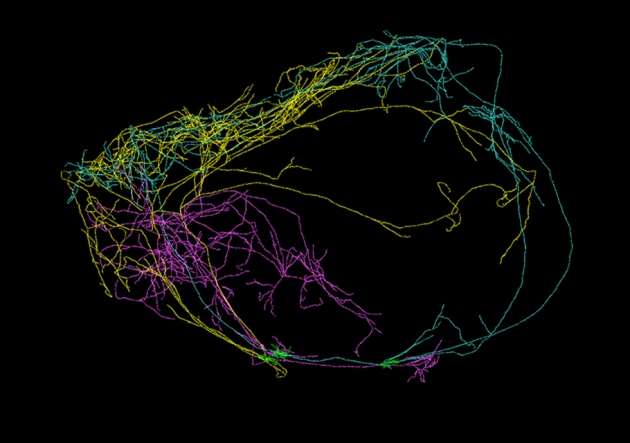A neuron that encircles the mouse brain. Credit: Allen Institute for Brain Science
(Medical Xpress)—A team of researchers with the Allen Institute for Brain Science led by Christof Koch gave a presentation recently at the Brain Research through Advancing Innovative Neurotechnologies meeting outlining research they have been conducting focused on individual nerve cells in the claustrum—a densely packed layer of grey matter located beneath the neocortex. The highlight of their talk was news of the team's discovery of what they described as giant neurons emanating from the claustrum, one of which was long enough to encircle the entire rest of the brain.
Koch has been heavily involved in studying the claustrum. Prior research teams he has worked with have found evidence suggesting that it is the part of the brain that is most associated with consciousness. At the meeting, he also gave highlights of an account by doctors attempting to help a female patient suffering from epilepsy back in 2014—they had found that using an electrode to stimulate the claustrum appeared to switch her consciousness on and off. In this new effort, he and his team were studying the role individual neurons play in the function of the claustrum. To that end, they induce gene activation in the claustrum neurons of several mice and then fed them very small amounts of a drug that would cause the activation.
Doing so caused the production of a protein that spread throughout the individual claustrum neurons, which fluoresced when activated. Next, the team took 10,000 cross sectional images of the mouse brains, which were fed to a computer, producing 3-D images of just the cells that were glowing—the three giant cells they spoke about. They noted that each of the cells had extensive connections with other neurons throughout various parts of the brain.
The researchers do not know the purpose of the giant neurons, but suggest it appears likely they serve a coordination purpose by dealing with incoming and outgoing signals from other parts of the brain—another sign that the claustrum is truly the part of the brain that holds what we experience as consciousness. It is still not clear, of course, if humans have similar giant neurons, and whether they truly serve as a main conduit for information processing in our brains.
More information: F. C. Crick et al. What is the function of the claustrum?, Philosophical Transactions of the Royal Society B: Biological Sciences (2005). DOI: 10.1098/rstb.2005.1661
Carinna M. Torgerson et al. The DTI connectivity of the human claustrum, Human Brain Mapping (2015). DOI: 10.1002/hbm.22667
Journal information: Human Brain Mapping
© 2017 Medical Xpress























